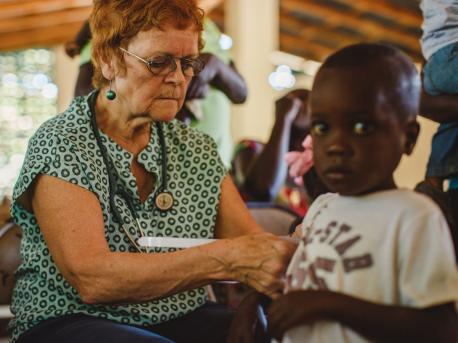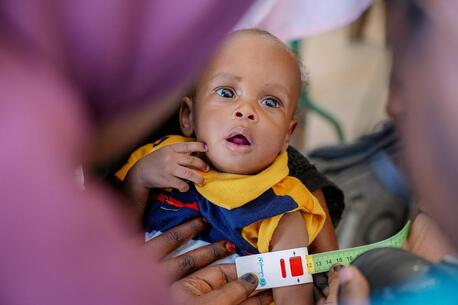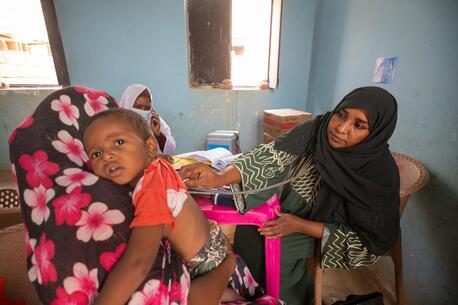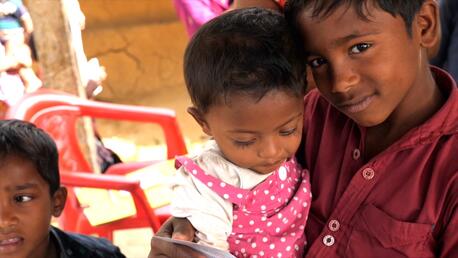
Bringing Malnourished Kids Back to Life in Haiti
From St. Louis pediatric endocrinologist to founder of a nonprofit that produces Ready-to-Use Therapeutic Food for malnourished children in Haiti and beyond, Dr. Patricia B. Wolff has spent decades improving the lives of those around her.
UNICEF treated more than 4 million severely malnourished children in 2018. Four out of five survived, thanks in large part to Ready-to-Use Therapeutic Food (RUTF), an easily digested protein- and vitamin-rich peanut paste. UNICEF is the world's largest provider of RUTF, procuring between 75 and 80 percent of the world's supply of the lifesaving malnutrition treatment.
Pediatrician Patricia B. Wolff began volunteering in Haiti in 1988. Her work there led her to found Meds & Food for Kids (MFK), a nonprofit dedicated to treating and preventing child malnutrition by developing, producing and distributing highly nutritious foods, including RUTF. In 2012, MFK opened a state-of-the-art factory just outside Cap-Haïtien, Haiti that produces all the RUTF used in Haiti — and ships to 14 countries, via UNICEF.
Below, Dr. Wolff's story in her own words:

Severely malnourished children treated with Ready-to-Use-Therapeutic Food, a shelf-stable nutrient-rich peanut paste called Medika Mamba in Haiti, are cured in six to twelve weeks. © Meds & Food for Kids
What drew you to humanitarian work?
PATRICIA B. WOLFF: I went to a Catholic school and the nuns were always telling us about poverty in the world and how we all had it pretty good in America and that we had a responsibility to make the world a better place. So I went to medical school and got married and had kids. I chose to be a pediatrician in medical school because I liked the pediatricians better than the other doctors, really. I realized that children fill you up in a way that adults kind of suck you dry.
I worked for 35 years in St. Louis in pediatrics and endocrinology, and overlapping with that, most of those years I was volunteering in Haiti. In 1986, Baby Doc [Duvalier] was deposed and from 1986 to 1988, there were five coups. In 1988, I went with a local group of people led by a couple that had been Peace Corps volunteers in Haiti years before, to stay in an orphanage in Port-au-Prince and visit Mother Teresa's homes for dying children and adults.
What I wasn't prepared for was that people [in Haiti] were dying for lack of very simple things... Curable diseases were going untreated for lack of supplies. There was nothing there.
I knew ahead of time that the mission of the Missionaries of Charity was to console the dying. But what I wasn't prepared for was that people were dying for lack of very simple things like tuberculosis medicine, Amoxicillin and IVs for dehydration. Curable diseases were going untreated for lack of supplies. There was nothing there.
One day, we went up the mountain to a place where the leader had given them money to build a clinic because he said, "If you build it, they will come." It took them a couple of years to round up two doctors — me and another doctor from St. Louis — to go there.

"It really takes a huge amount of resources and persistence and follow-through with the details," says Dr. Patricia B. Wolff, who founded her Haiti nonprofit, Meds & Food for Kids, in 2004. © Meds & Food for Kids
What happened on your first day at the clinic?
PATRICIA B. WOLFF: People walked all night to see a doctor, the first doctor they'd ever seen. Three hundred people showed up that first day and they had godawful things that we were in no way prepared to treat, with our few little medicines that we brought up the mountain on horses and mules. It was quite a humbling, upsetting, grief-inducing experience. We stayed for three days and did our best, but it wasn't much really, to tell you the truth.
I was just determined to come back, to do whatever I could. So I came back one week a year, then two weeks a year, then three weeks, then four.
I was in Haiti for a total of two weeks with my children and my husband and what we saw changed our lives forever. There were dead bodies on the street that no one would pick up because they were political killings. Nobody had anyplace to put the bodies, because it was quite a dysfunctional country at that point.
I was just determined to come back, to do whatever I could. So I came back one week a year, then two weeks a year, then three weeks, then four.
How did you decide to focus on malnutrition?
PATRICIA B. WOLFF: I spent 15 years treating sick kids in a rural clinic as a volunteer. One of those children had a mother with thyroid disease. I made it a mission to get her lab tests and the right medicine from America. She had already lost a child to sickness and she had a new baby. Another year passed, and her baby was very malnourished. So we did what we could for him, which wasn't much. We gave him a little rice and beans and that was about it. He got sicker and went to the hospital and they had to pay a big bill. The next time I went back, he had died.
Meanwhile, my colleague at Washington University, Dr. Mark Manary, a pediatrician who's well known in the malnutrition community, was doing research in Malawi on a new recipe that he and [French pediatric nutritionist] André Briend had developed as outpatient therapy for malnutrition. Before that, the World Health Organization recommendation was to give milk, sugar and oil mixed with vitamins and minerals, which required refrigeration and a hospital to administer, which was very expensive.
What were the ingredients in their new formula?
I think Briend was inspired by Nutella, which is made of hazel nuts. He thought, you could make this with peanuts, which are available everywhere, and powdered milk, sugar and oil, and add vitamins and minerals to it. Why would they need to be in the hospital? They could just take it home. It would keep stable at tropical room temperatures. Children could just come in for check-ups every week or two, depending on how sick they were.
I went to visit Manary in 2000 and 2001 when he was making this peanut paste in the hospital clinic in Blantyre, Malawi and taking it out to the suburbs as an experiment to see how it would be accepted. And he was just beginning to get these fantastic outcomes.

Meds & Food for Kids trains farmers in northern Haiti on how to produce peanuts low in aflatoxin, for use in Ready-to-Use Therapeutic Food. © Meds & Food for Kids
So he gave me his recipe and I said, "We can do this in Haiti!" We went to the market and bought all the ingredients and had a guy on the street grind the peanuts into peanut butter so we could add the powdered milk, sugar and oil. We didn't have the vitamins and minerals, but we started giving it out at the clinic I had been going to for years. And it was miraculous.
The kids would come in lethargic, lifeless, with their skin not as black as it really should be and their hair red instead of black. Within a week, they were sitting up and they had little black roots and their skin started to darken. Within six or eight or twelve weeks, they were cured. They were back to their normal selves again.
How did you scale up production?
PATRICIA B. WOLFF: We got a little hand grinder from Compatible Technologies International in Minnesota, a nonprofit group of engineers who make simple machines for food in one way or another for the developing world. And we started making this peanut paste with the hand grinder. In 2003, we made 100 kilograms [200 pounds] a month by hand. Since then, we have upgraded many times and moved six times. Now we have a big factory that can produce 4 million kilograms of Ready-to-Use Therapeutic Food [RUTF] a year.
We started making this peanut paste with the hand grinder. In 2003, we made 100 kilograms [200 pounds] a month by hand... Now we have a big factory that can produce 4 million kilograms of Ready-to-Use Therapeutic Food a year.
We have had UNICEF as our customer for many years, World Food Program, World Vision, Save the Children, Catholic Relief Services, 200 mission groups across Haiti. And we can now proudly say that we have been the engine of the production of RUTF for over 350,000 kids around the world.
Have you always used peanuts grown in Haiti?
PATRICIA B. WOLFF: We were using locally sourced peanuts from the beginning, until we got sophisticated about aflatoxin. Then we knew we had to be very particular about the peanuts. Aflatoxin is produced by fungi called Aspergillus. It's bad for you and it affects peanuts all over the world. It's bad for children because it inhibits the absorption of protein. It's probably a cause of stunting and for sure it causes immune deficiency. It's bad for adults because it's the major cause of liver cancer in the world today.
So we knew we had to do something about that, which meant that we had to develop programs to educate the farmers because the way to prevent aflatoxin is for farmers to change their practices, using things like tarps for drying and breathable bags for storage and a dry place to store the peanuts.
Many of these things sound simple, but they're not zero cost and they are not available to most of the peanut farmers in Haiti. So we have also imported peanuts over the years. We buy as many local peanuts as we're able to get that are low in aflatoxin.
How low?
PATRICIA B. WOLFF: When we first started measuring aflatoxin with the help of Cornell University's Toxicology Department, we found that very frequently peanuts in the market had aflatoxin levels of 300 to 3,000 parts per million. The standard in the U.S. is 20 parts per million. In Europe, the standard is 10.
Because of our farmer training work in northern Haiti, if you go to the market today, you'll find levels of 20 to 300, not 300 to 3,000. We're able to buy 50 metric tons of low-aflatoxin peanuts every year in Haiti. When we purchase peanuts from a Haitian farmer, we are supporting his family by providing a market for his crops. By providing jobs for Haitian people, we help break the cycle of poverty that leads to malnutrition.

Workers at the state-of-the-art Meds & Food for Kids (MFK) factory just outside Cap Haïtien, Haiti make up to 4 million kilograms of Ready-to-Use Therapeutic Food (RUTF) a year. MFK ships RUTF to 14 countries via UNICEF. © Meds & Food for Kids
This is quite an achievement. How do you get it all done?
PATRICIA B. WOLFF: I'm in Haiti two weeks and I'm in St. Louis two to four weeks, because this job is basically three jobs. It's about the malnutrition programs and the farmer programs and the production facility in Haiti. But it's also about fundraising in St. Louis and about getting people with skills to help us, like engineers or construction people or university nutritionists.
Are you aware of any programs elsewhere that have been modeled on yours?
PATRICIA B. WOLFF: We have had a lot of people come and see what we do. There have been attempts at doing this in various countries, Haiti included. But it really takes a huge amount of resources and persistence and follow-through with the details.
I think one of my skill sets beyond persistence is actually figuring out what we need and then calling people and asking them to do a specific thing for us. While most people are very busy and can't devote their lives to this, they can do a specific thing. Over the years, we put together thousands of little things to make the whole.

A mother carries her child and a carton of Ready-to-Use Therapeutic Food (RUTF) in Haiti. According to Wolff, RUTF tastes like the inside of Reese's Pieces candy. © Meds & Food For Kids
Is there a cycle of malnutrition? Do you see the same children recovering from malnutrition and then relapsing?
PATRICIA B. WOLFF: Sometimes kids are kind of borderline malnourished and then they get sick with a cold or pneumonia or diarrhea and the parents don't have many resources and they think, "That kid is not going to make it. And we've got these other kids to take care of."
So subtly, resources get transferred to the other kids. There's a lot of belief that there is no hope for these kids from the medical community, that they have been cursed. And that if you've already been to the voodoo practitioner and the curse has not been lifted, then the kids are going to die.
When you get really malnourished, you quit complaining. You just sit in the corner and fade away.
When you get really malnourished, you quit complaining. You just sit in the corner and fade away. But when we first started doing this and we had mobile clinics and we talked up our product and we gave it away to as many people as would distribute it, what happened is word got out and more people were willing to try it. And it was miraculous! Everybody got better.
How old are the children suffering from severe acute malnutrition, typically?
PATRICIA B. WOLFF: They're usually 12 to 36 months old. Most babies under 6 months are not malnourished, but if the mom quits breastfeeding at 6 months because she has to go back to work, then many of those kids will be quite malnourished by 12 months, certainly by 18 months, and they can't get food on their own. Anybody who's over 3 will just wander out of bed and go ask the neighbor for food. But under age 3, they don't.
You have given so many children a chance to thrive. Can you tell us a story about a child you remember?
PATRICIA B. WOLFF: There was a little boy named Alexa who was brought to a clinic down the road from us about eight or nine years ago. He was 7 years old and weighed 21 pounds. His older sibling had died. His mother didn't have any money, or any way of making money, but she brought him to the clinic. The people there called me and said, "We heard that you make this stuff. Can we get some of it and use it on him?" And I said, "Well, of course."
They didn't have a hospital there, but a nurse in the clinic let the little boy stay in her room with her, because he was very fragile. She fed him like a bird, little by little. We were in phone contact and I went there a couple times to check on him. Over the next seven, eight weeks, they completely saved this boy's life.
His hair was pure white and his skin was very pale. Eventually his hair and skin darkened and he got stronger. Now he's the star of his school's soccer team.
Learn more about Meds & Food for Kids.
Help end global malnutrition by supporting UNICEF's nutrition programs.
Top photo: Meds & Food for Kids founder Dr. Patricia B. Wolff has been treating malnourished chilidren in Haiti since 1988. © Meds & Food for Kids
HOW TO HELP
There are many ways to make a difference
War, famine, poverty, natural disasters — threats to the world's children keep coming. But UNICEF won't stop working to keep children healthy and safe.
UNICEF works in over 190 countries and territories — more places than any other children's organization. UNICEF has the world's largest humanitarian warehouse and, when disaster strikes, can get supplies almost anywhere within 72 hours. Constantly innovating, always advocating for a better world for children, UNICEF works to ensure that every child can grow up healthy, educated, protected and respected.
Would you like to help give all children the opportunity to reach their full potential? There are many ways to get involved.





